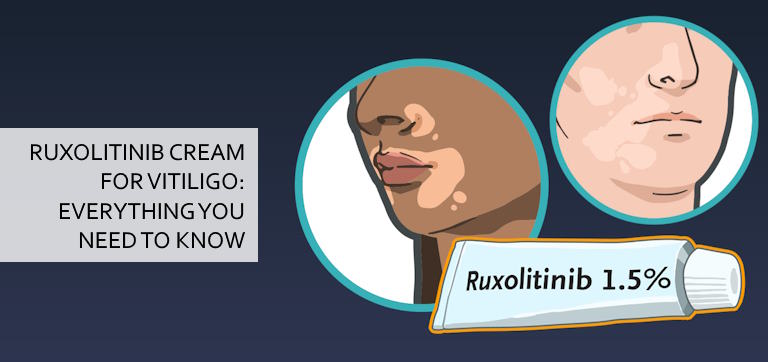Ruxolitinib Cream for Vitiligo: Everything You Need to Know
Table of Contents
Vitiligo is a skin condition in which loss of skin pigmentation occurs frequently, also leading toward the white patches of the skin, characterized as a chronic skin condition. This affects any part of the body severely and has noteworthy psychological impacts on individuals who experience it. So many options are available to treat this condition, but the most significant treatment is using the Ruxolitinib cream. In this article there will be a comprehensive guide on Ruxolitinib cream for this chronic skin condition, covering everything from how it works to where you can buy it.
Understanding Vitiligo
Vitiligo is a long-term condition characterized by patches of skin losing their pigment. The exact cause of vitiligo is not entirely understood, but it is believed to be multifactorial, involving a combination of genetic, autoimmune, environmental, and biochemical factors. Here’s a detailed overview of the causes and factors affecting vitiligo:
Causes of Vitiligo
Autoimmune Response
- Immune System Attack: In vitiligo, the immune system mistakenly attacks and destroys melanocytes, the cells responsible for producing melanin, the pigment that gives skin its color.
- Cytotoxicity: Cytotoxic T cells (a type of immune cell) are thought to play a role in the destruction of melanocytes.
Genetic Factors
- Family History: There is a higher likelihood of developing vitiligo if a close family member also has the condition.
- Genetic Mutations: Certain gene mutations have been associated with an increased risk of vitiligo, including those involved in the immune response and melanocyte function.
Environmental Triggers
- Sunburn: Severe sunburn or other skin damage can trigger vitiligo in predisposed individuals.
- Chemical Exposure: Exposure to certain chemicals, such as those found in industrial or occupational settings, can precipitate vitiligo.
Neurogenic Factors
- Nerve Involvement: There is a theory that neurochemical factors released from nerve endings might contribute to the destruction of melanocytes.
Factors Affecting Vitiligo
Genetics
- Inheritance Patterns: While vitiligo can run in families, the inheritance pattern is complex and not fully understood.
- Specific Genes: Variations in certain genes, such as those involved in the immune system, have been linked to an increased risk of vitiligo.
Immune System
- Autoimmune Diseases: Individuals with vitiligo are more likely to have other autoimmune disorders, such as thyroid disease, rheumatoid arthritis, or type 1 diabetes.
- Immune Response Modulation: Factors that influence the immune system’s activity can affect the progression of vitiligo.
Stress
- Emotional Stress: Psychological stress has been reported to trigger or exacerbate vitiligo in some individuals.
- Physical Stress: Physical stressors, such as illness or trauma, may also play a role.
Skin Trauma
- Koebner Phenomenon: New patches of vitiligo can develop at sites of skin injury, such as cuts, abrasions, or pressure points.
Exposure to Chemicals
- Occupational Exposure: Workers exposed to certain chemicals, such as phenols or catechols, may have an increased risk of developing vitiligo.
Diet and Nutrition
- Nutritional Deficiencies: Deficiencies in certain nutrients, such as vitamin B12, folic acid, and copper, have been associated with vitiligo.
- Oxidative Stress: Diets high in antioxidants may help mitigate oxidative stress, potentially influencing the progression of vitiligo.
Sun Exposure
- UV Radiation: Excessive sun exposure can trigger or worsen vitiligo, although controlled phototherapy is sometimes used as a treatment.
Symptoms of Vitiligo
-
Depigmented Patches
- Appearance: White or light-colored patches on the skin, often with well-defined borders.
- Common Sites: Frequently affects areas exposed to the sun such as the face, hands, arms, and feet, as well as body folds (armpits, groin), and places of previous injury.
-
Hair Changes
- Premature Graying: Hair on the scalp, eyebrows, eyelashes, and beard may turn gray or white early.
- Depigmented Hair: Hair growing in areas affected by vitiligo may also lose its color.
-
Mucosal Involvement
- Mucous Membranes: Depigmentation can affect the inside of the mouth, nose, and genitals.
-
Eye Involvement
- Iris Color: Changes in the color of the retina or parts of the iris can occur in some cases.
-
Sensitivity to Sunlight
- Sunburn: Affected areas of skin can be more sensitive to sunlight and prone to sunburn.
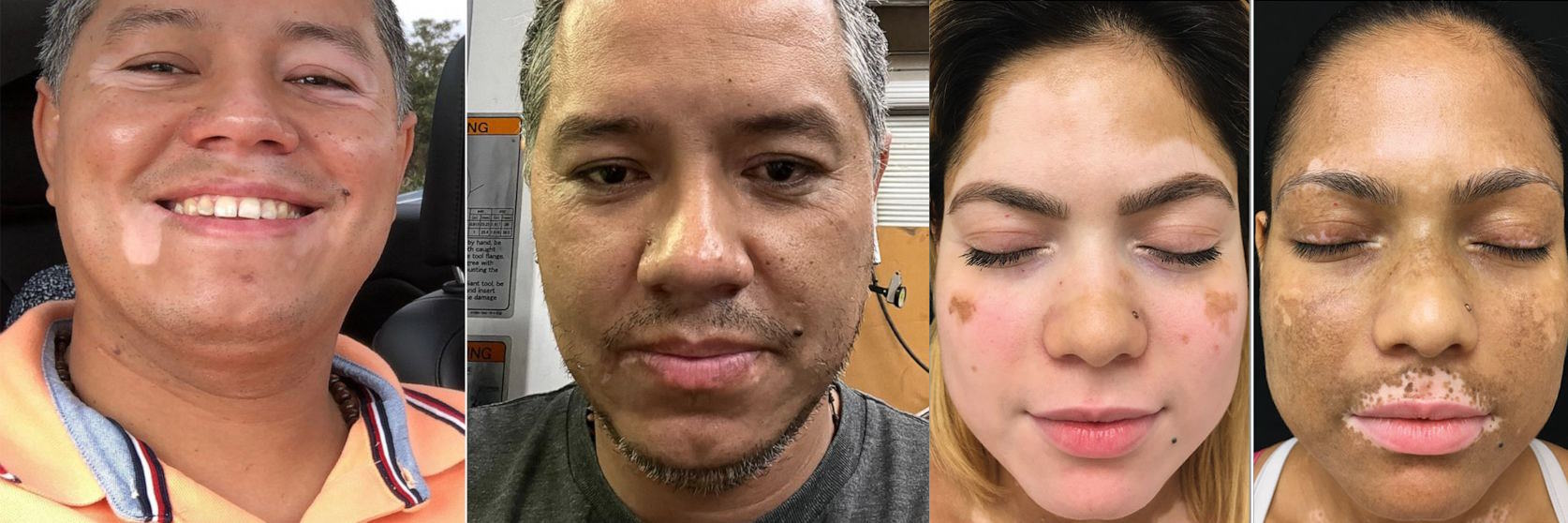
Diagnosis of Vitiligo
-
Medical History and Physical Examination
- History: A thorough history of the patient’s symptoms, family history of vitiligo or other autoimmune diseases, and potential triggers (e.g., sunburn, stress, skin trauma).
- Examination: Physical examination to identify the characteristic white patches on the skin.
-
Wood’s Lamp Examination
- UV Light: A Wood lamp (UV light) can help to highlight depigmented areas more clearly, especially on lighter skin tones.
-
Skin Biopsy
- Histopathology: A biopsy may be performed to confirm the absence of melanocytes in the depigmented skin and rule out other conditions that may mimic vitiligo.
-
Blood Tests
- Autoimmune Screening: Blood tests can help identify other autoimmune conditions commonly associated with vitiligo, such as thyroid dysfunction, diabetes, or pernicious anemia.
- Nutritional Deficiencies: Tests for levels of vitamin B12, folic acid, and other nutrients may be conducted.
-
Eye Examination
- Ophthalmologic Evaluation: An eye examination can detect changes in the retina or iris that might be associated with vitiligo.
-
Imaging Studies
- Advanced Imaging: In rare cases, advanced imaging like reflectance confocal microscopy or optical coherence tomography may be used for detailed analysis of the skin.
-
Genetic Testing
- Genetic Markers: Though not routine, genetic testing may be considered in research settings to identify specific gene mutations associated with vitiligo.
Differential Diagnosis
Several other conditions can cause hypopigmented or depigmented patches on the skin and must be differentiated from vitiligo:
- Pityriasis Alba
- Mildly scaly, hypopigmented patches: Usually seen in children.
- Tinea Versicolor
- Fungal Infection: Characterized by fine scaling and often affects the upper trunk.
- Post-inflammatory Hypopigmentation
- After Skin Trauma: Hypopigmentation following inflammatory skin conditions or trauma.
- Albinism
- Genetic Disorder: Characterized by a lack of pigment in the skin, hair, and eyes from birth.
- Chronic Condition: Causes thin, white patches of skin, typically in the genital and anal areas.
By combining patient history, physical examination, and various diagnostic tests, healthcare providers can accurately diagnose vitiligo and differentiate it from other conditions with similar presentations.
What is Ruxolitinib Cream?
Ruxolitinib cream is a topical medicine used for the treatment of vitiligo. It is comprised of Ruxolitinib, a Janus kinase (JAK) inhibitor, which is used to modulate the immunological response that causes depigmentation in vitiligo. Ruxolitinib cream works by modifying the immune system’s activity, and also it helps to restore pigmentation in afflicted areas.
-
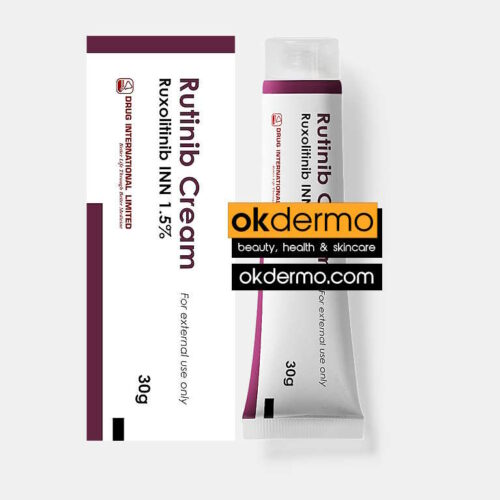
Rutinib® Ruxolitinib Cream
Ruxolitinib 1.5%
Size: 30g / 1.05oz
Brand name: Opzelura
USD $440.00 Add to cart -
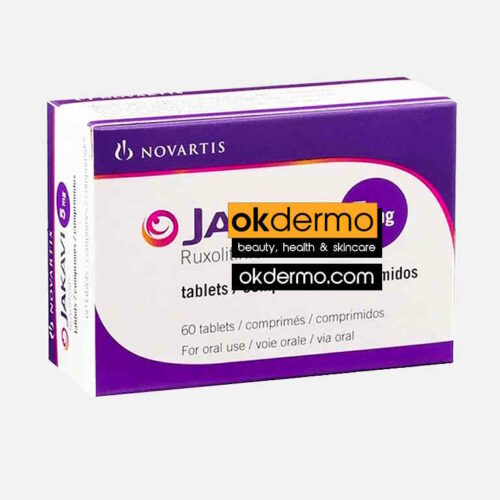
Jakavi® Ruxolitinib Tablets
Ruxolitinib 5mg / 20mg
Size: 10 Tablets
Brand name: Jakafi
From USD $560.00 Select options This product has multiple variants. The options may be chosen on the product page
How Ruxolitinib Cream Works for Vitiligo
Ruxolitinib functions by blocking the pathways JAK1 and JAK2, which are implicated in the inflammatory process that leads to the immune system targeting melanocytes, the cells that produce pigment. Ruxolitinib promotes skin repigmentation by reducing inflammation and enabling normal melanocyte activity by inhibiting these pathways.
Mechanism of Action
The JAK-STAT pathway is a key regulator of the immune system. If there is any kind of overactivity, then these pathways lead to an autoimmune response, which is against the melanocytes. Whereas, Ruxolitinib cream disturbs this process, reducing inflammation and protecting against further loss of pigmentation.
Dosage and Application
Recommended Dosage
Apply Ruxolitinib cream twice a day to the affected areas, this is the typical dosage. Do not use this cream excessively but the amount of the cream should be enough to cover the white patches of the skin.
Application Instructions
- Cleanse the Area: Clean the affected area of the skin with mild soap and water before applying the cream.
- Apply the Cream: Take a small amount of cream and gently apply it to the affected areas of the skin.
- Massage Gently: Massage the cream into the skin until it is fully absorbed.
- Wash Hands: After applying the cream, wash your hands carefully to remove any remaining cream.
Tips for Effective Application
- Consistency: Note the time when you apply the cream, then apply it at the same times each day, and be consistent with this medication.
- Avoid Overuse: Just use the recommended amount of the cream, more cream will not increase the effectiveness and may increase the risk of side effects.
- Protect Treated Areas: use sunscreen to protect yourself from sunburn, if you are exposed to the sunlight.
Expected Results and Timeline
Initial Results
Most patients want results within some weeks of the starting treatment. A decrease in the size of white patches and the emergence of tiny regions of repigmentation could be early indicators of improvement.
Long-Term Results
After consistent use of cream, significant improvements occur within several months. After 6-12 months full effect of the treatment is seen, with continued use potentially leading to nearcomplete repigmentation in some patients.
Clinical Studies
Ruxolitinib cream has been confirmed in clinical trials to be useful in depigmenting vitiligo spots. According to studies, people who use Ruxolitinib cream have significantly more repigmentation than those who use a placebo.
Real-Life Experiences
Most of the users give positive feedback about the Ruxolitinib cream with the improving skin appearance and also giving confidence. Meanwhile, results depend upon the user and the extent of the condition.
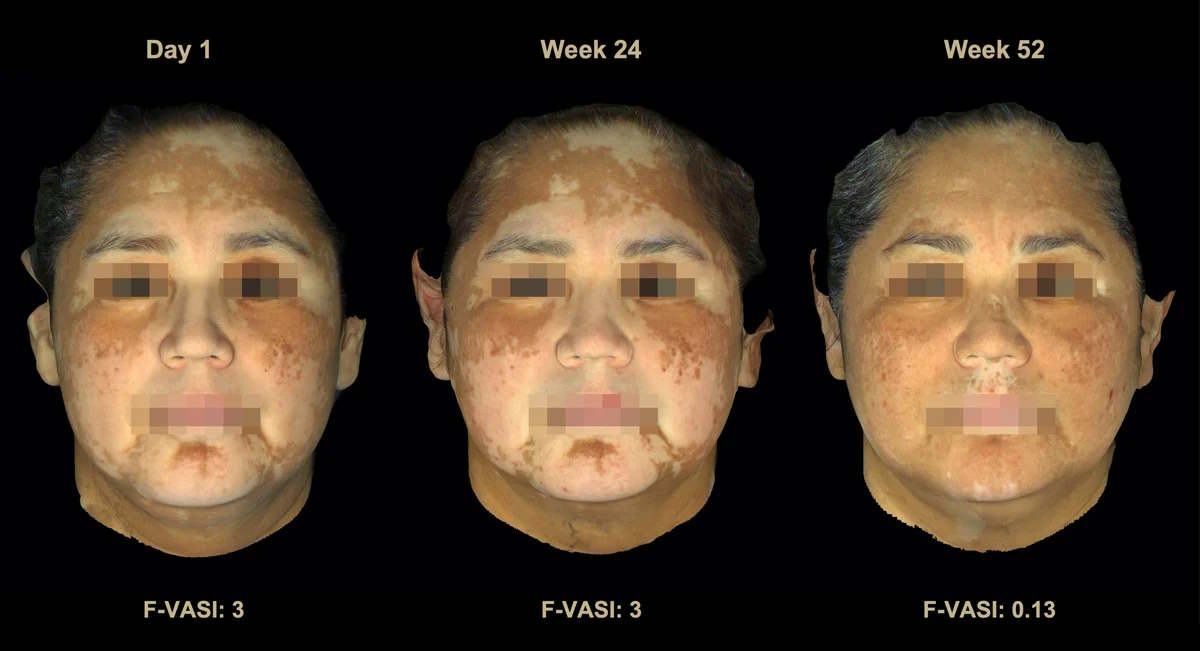
Side Effects and Considerations
Common Side Effects
- Skin Irritation: patients with vitiligo may experience mild skin irritation at the applied site, including redness or burning sensation.
- Dry Skin: Ruxolitinib cream can cause dryness in the treated areas.
Serious Side Effects
- Increased Risk of Infections: Ruxolitinib cream may increase the risk of skin infections, by controlling the immune response.
- Allergic Reactions: mostly users face allergic reactions to the cream, but it happens in rare cases.
Precautions
- Patch Test: Apply a small amount of cream to a discrete area of skin before beginning the whole treatment to check for any negative responses.
- Consultation: It is suitable to begin any treatment, always get advice from a medical practitioner to make sure it is appropriate for your situation.
Contraindications
People who have specific sensitivities or medical issues shouldn’t use Roxolitinib cream. Consult your healthcare professional about your medical history to find out if this treatment is appropriate for you or not.
Monitoring and Follow-Up
To monitor your progress and adjust treatment as needed, make follow-up appointments with your healthcare professional. If you are facing any sort of side effects or lack of improvements then consult your doctor immediately.
Comparing Ruxolitinib and Opzelura
What is Opzelura?
One version of ruxolitinib cream, specifically at a concentration of 1.5%, is marketed under the name Opzelura. Vitiligo and other inflammatory skin diseases are also treated with it.
Effectiveness
In the treatment of Vitiligo, both Opzelura and Ruxolitinib are effective. According to the studies, comparable results reduce the vitiligo patches in terms of repigmentation.
Price and Availability
Ruxolitinib cream is cheap, whereas Opzelura is more expensive as compared to Ruxolitinib. Opzelura is more accessible in certain regions as compared to Ruxolitinib.
Pros and Cons
Ruxolitinib Cream:
- Pros: Generally less expensive, available via okdermo.com
- Cons: May have varying concentrations.
Opzelura:
- Pros: Specifically formulated for dermatological use, consistent concentration.
- Cons: Higher cost.
User Experiences
Both Opzelura and Ruxolitinib have been well-acknowledged by patients, with many expressing notable improvements in their vitiligo. Because of its standardized formulation, Opzelura is preferred by certain users, whereas generic Ruxolitinib is preferred by others because of its lower cost.
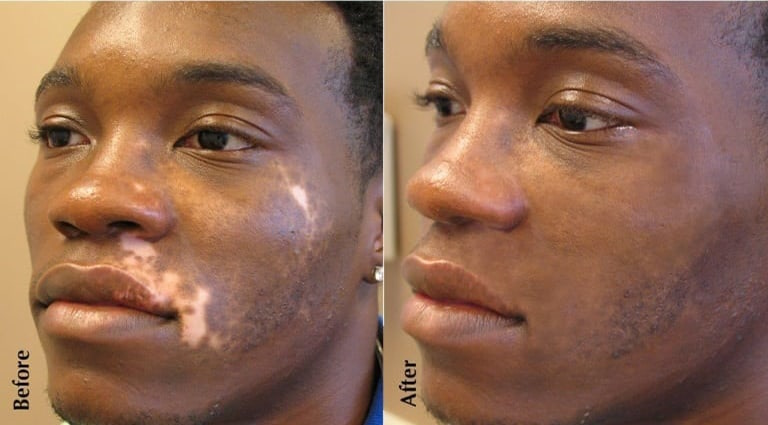
Frequently Asked Questions (FAQs)
How long does it take for ruxolitinib to work for vitiligo?
The duration of action of Roxolitinib cream varies from person to person. While there may be noticeable results in a few weeks, repigmentation often takes six to twelve months of continuous use.
How to use ruxolitinib cream for vitiligo?
The afflicted areas should get two daily applications of Ruxolitinib cream. Before applying the cream, wash your skin, then use a tiny amount and gently massage it into your skin until it is completely absorbed.
What are the side effects of ruxolitinib cream for vitiligo?
The most common side effects of Ruxolitinib cream for vitiligo include skin irritation, redness, itching, and dry skin. Serious side effects can include an increased risk of infections and allergic reactions.
What are the cons of Opzelura?
The cons of Opzelura include that it is more expensive than generic Ruxolitinib creams and that it may cause adverse effects such as skin irritation and an elevated risk of infections, which are also possible with Ruxolitinib.
Conclusion
Vitiligo sufferers may find that Roxolitinib cream is a viable therapeutic choice. Ruxolitinib cream can dramatically improve the appearance of vitiligo patches because of its capacity to block the JAK-STAT pathway and encourage repigmentation. Patients may choose wisely when adding Ruxolitinib cream to their skincare routine by being aware of the recommended usage, anticipated outcomes, and any adverse effects. Before beginning any new treatment, always get advice from a medical practitioner to make sure it is suitable for your unique circumstances.
References:
- Joge, R. R., Kathane, P. U., & Joshi, S. H. (2022). Vitiligo: A Narrative Review Article. Curēus. https://doi.org/10.7759/cureus.29307
- (2017, April 12). Vitiligo. National Institute of Arthritis and Musculoskeletal and Skin Diseases. https://www.niams.nih.gov/health-topics/vitiligo
- Iqbal, A., & Salman, M. (2023). Do the benefits of Opzelura (Ruxolitinib) outweigh the potential risks? An insight into the FDA-approved treatment for non-segmental vitiligo (NSV). International Journal of Surgery Open, 55, 100630–100630. https://doi.org/10.1016/j.ijso.2023.100630
- Rosmarin, D., Pandya, A. G., Lebwohl, M., Grimes, P., Iltefat Hamzavi, Gottlieb, A. B., Butler, K., Kuo, F., Sun, K., Ji, T., Howell, M. D., & Harris, J. E. (2020). Ruxolitinib cream for the treatment of vitiligo: a randomized, controlled, phase 2 trial. Lancet, 396(10244), 110–120. https://doi.org/10.1016/s0140-6736(20)30609-7
- Hoy, S. M. (2022). Ruxolitinib Cream 1.5%: A Review in Mild to Moderate Atopic Dermatitis. American Journal of Clinical Dermatology, 24(1), 143–151. https://doi.org/10.1007/s40257-022-00748-2
Post by:
Dr.Marcella Jiovanni
Health and Beauty Expert
“Marcella Jiovanni actively promotes the importance of maintaining healthy skin, she envisions the future of dermatology as moving away from pure medical, pharmacological dermatology and flowing more toward a holistic approach to wellness and skincare.”

